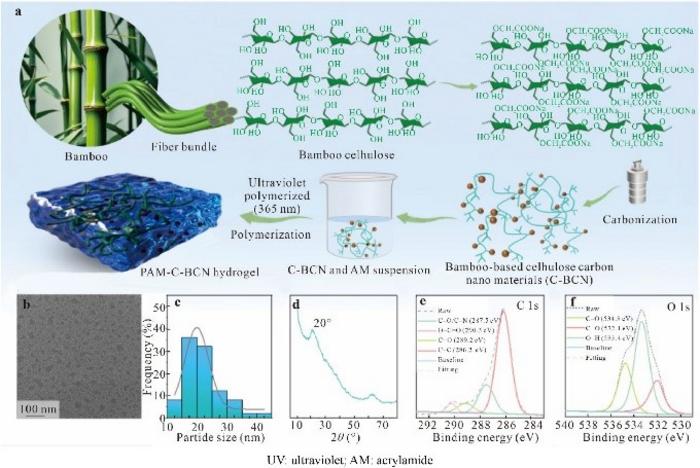In the relentless quest to develop materials that combine flexibility, durability, and functionality, a novel breakthrough in hydrogel technology shines a promising light on the future of wearable electronics and soft robotics. Engineers and material scientists from Southwest Forestry University in China have synthesized an ultra-robust hydrogel utilizing bamboo cellulose-based carbon nanomaterials (C-BCN), a development that could set new standards in the performance of flexible devices.
Hydrogels, traditionally celebrated for their biocompatibility and water-rich matrix, have faced significant impediments when considered for intensive applications. Their inherent mechanical fragility and limited durability often render them unsuitable for environments demanding both resilience and flexibility. By integrating carbon nanomaterials derived from bamboo cellulose into a polyacrylamide (PAM) matrix, this research team has crafted a composite hydrogel (PAM-C-BCN) exhibiting exceptional strength, elasticity, and conductivity.
The fabrication process of this innovative hydrogel begins with treating raw bamboo fibers through a chemical modification using phthalic anhydride. This modification facilitates the later carbonization step, transforming the treated fibers into carbon nanomaterials imbued with high surface area and remarkable mechanical characteristics. The carbonized bamboo cellulose nanomaterials are then uniformly incorporated into an acrylamide precursor solution, which polymerizes into the final hydrogel network.
This hybrid hydrogel demonstrates mechanical properties that are significantly enhanced compared to conventional hydrogels. Specifically, the PAM-C-BCN hydrogel exhibits a fracture strength of 363 kPa, an elongation exceeding 2,254%, and a fracture energy of 30 kJ/m². Such metrics reflect a composite that can endure substantial tensile forces while maintaining elasticity and resisting crack propagation—a feat uncommon in hydrogels engineered for wearable technologies.
One of the pivotal scientific achievements lies in the intricate interfacial interactions between the carbon nanomaterials and the PAM polymer chains. These interactions establish a densely interpenetrated network responsible for efficient energy dissipation when the material undergoes mechanical stress. The densely cross-linked nanocomposite matrix prevents crack initiation and propagation, thereby endowing the hydrogel with outstanding fatigue resistance, an essential attribute for devices subjected to repetitive bending and stretching.
Beyond mechanical robustness, the hydrogel’s adhesive properties were rigorously evaluated. The PAM-C-BCN hydrogel displayed adhesion strength up to 7.5 kPa on biological substrates such as pigskin, indicating its potential for secure attachment to human skin. This adhesion, without the use of synthetic glue or external adhesives, supports its candidacy for applications involving direct skin contact, such as electronic skin patches or biosensors.
Electrically, the integration of C-BCN significantly enhances the hydrogel’s conductivity, measured at 0.21 S/m. This advancement is attributable to the conductive pathways formed by the carbon nanomaterials, which facilitate electron transport through the hydrogel matrix. Enhanced conductivity paired with mechanical integrity positions the PAM-C-BCN hydrogel as an ideal medium for transmitting electrical signals in flexible electronics.
The implications of this research reach far into the landscape of flexible electronics, wearable health monitoring systems, and soft robotics. Traditional materials struggle to reconcile the conflict between mechanical strength and functional performance, especially in devices that must conform to irregular surfaces and withstand dynamic stresses. The PAM-C-BCN hydrogel effectively straddles this divide by uniting superior mechanical resilience with conductive and adhesive properties.
Furthermore, this bio-derived nanomaterial approach aligns with sustainability goals, leveraging bamboo, a renewable and rapidly growing natural resource, to produce advanced functional materials. The environmental benefits of replacing synthetic or petroleum-based components with bamboo cellulose not only minimize ecological footprints but also offer cost-effective manufacturing opportunities.
Researchers acknowledge that while the preliminary results are compelling, further refinement in the synthesis and processing of C-BCN is anticipated to unlock even greater performance gains. Optimizing factors such as fiber treatment conditions, carbonization parameters, and dispersion within the polymer matrix could enhance the hydrogel’s mechanical and electrical properties.
Importantly, the hydrogel’s capacity to effectively restrain crack propagation under continuous stress sets an industry benchmark. This quality could dramatically extend the lifespan of wearable devices and electronic skins, reducing maintenance and replacement burdens. Additionally, the excellent fatigue resistance exhibited promises stable operation over countless deformation cycles, a critical requirement for practical applications.
The study, published in the Journal of Bioresources and Bioproducts, represents a significant stride toward multifunctional hydrogels tailored for next-generation wearable tech. As the trend toward personalized health monitoring and human-machine interfaces accelerates, materials like PAM-C-BCN offer a robust platform upon which these innovations can be reliably built.
In summary, the intersection of natural bamboo cellulose-derived carbon nanomaterials with synthetic polymer networks in this hydrogel creates a high-performance composite with mechanical toughness, conductivity, and stickiness—qualities indispensable for the advancing frontiers of flexible electronics and soft robotic devices. This pioneering work carves a path toward sustainable, biocompatible materials capable of meeting the rigorous demands of future technologies.
Subject of Research: Not applicable
Article Title: Fabricating Ultra-Robust Hydrogels with Adhesive Properties by Restraining Crack Propagation with Bamboo Cellulose-Based Carbon Nanomaterials
News Publication Date: 14-May-2025
Web References:
Journal of Bioresources and Bioproducts
DOI: 10.1016/j.jobab.2025.05.002
Image Credits: Yunnan Province Key Lab of Wood Adhesives and Glued Products, International Joint Research Center for Biomass Materials, School of Materials and Chemical Engineering, Southwest Forestry University, Kunming 650224, China
Keywords: Engineering, Agriculture, Environmental sciences
Tags: advanced hydrogels for intensive applicationsbamboo cellulose carbon nanomaterialsbiocompatible hydrogel technologycarbonized bamboo fiberschemical modification in materials scienceflexible wearable electronicshigh surface area materialsinnovative hydrogel fabricationmechanical strength and elasticitypolyacrylamide composite hydrogelssoft robotics materialsultra-robust hydrogels





